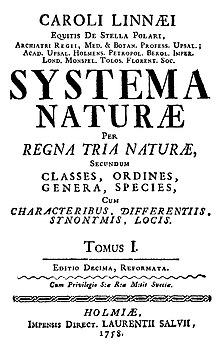Order (biology)
This articleneeds additional citations forverification.(May 2008) |

Order(Latin:ordo) is one of the eight majorhierarchicaltaxonomic ranks inLinnaean taxonomy.It is classified betweenfamilyandclass.Inbiological classification,the order is ataxonomic rankused in the classification of organisms and recognized by thenomenclature codes.An immediately higher rank,superorder,is sometimes added directly above order, withsuborderdirectly beneath order. An order can also be defined as a group of related families.
What does and does not belong to each order is determined by ataxonomist,as is whether a particular order should be recognized at all. Often there is no exact agreement, with different taxonomists each taking a different position. There are no hard rules that a taxonomist needs to follow in describing or recognizing an order. Some taxa are accepted almost universally, while others are recognized only rarely.[1]
The name of an order is usually written with a capital letter.[2]For some groups of organisms, their orders may follow consistent namingschemes.Orders ofplants,fungi,andalgaeuse the suffix-ales(e.g.Dictyotales).[3]Orders ofbirdsandfishesuse the Latin suffix-iformesmeaning 'having the form of' (e.g.Passeriformes), but orders ofmammalsandinvertebratesare not so consistent (e.g.Artiodactyla,Actiniaria,Primates).
Hierarchy of ranks[edit]
Zoology[edit]
For somecladescovered by theInternational Code of Zoological Nomenclature,several additional classifications are sometimes used, although not all of these are officially recognized.
| Name | Latinprefix | Examples |
|---|---|---|
| Magnorder | magnus,'large, great, important' | Boreoeutheria |
| Superorder | super,'above' | Euarchontoglires,Parareptilia |
| Grandorder | grand,'large' | Euarchonta |
| Mirorder | mirus,'wonderful, strange' | Primatomorpha,Ferae |
| Order | Primates,Procolophonomorpha | |
| Suborder | sub,'under' | Haplorrhini,Procolophonia |
| Infraorder | infra,'below' | Simiiformes,Hallucicrania |
| Parvorder | parvus,'small, unimportant' | Catarrhini |
In their 1997 classification ofmammals,McKennaand Bell used two extra levels between superorder and order:grandorderandmirorder.[4]Michael Novacek (1986) inserted them at the same position.Michael Benton(2005) inserted them between superorder and magnorder instead.[5]This position was adopted bySystema Naturae 2000and others.
Botany[edit]
Inbotany,the ranks of subclass and suborder are secondary ranks pre-defined as respectively above and below the rank of order.[6]Any number of further ranks can be used as long as they are clearly defined.[6]
The superorder rank is commonly used, with the ending-anaethat was initiated byArmen Takhtajan's publications from 1966 onwards.[7]
History[edit]
The order as a distinct rank of biological classification having its own distinctive name (and not just called ahigher genus(genus summum)) was first introduced by the German botanistAugustus Quirinus Rivinusin his classification of plants that appeared in a series of treatises in the 1690s.Carl Linnaeuswas the first to apply it consistently to the division of all three kingdoms of nature (thenminerals,plants,andanimals) in hisSystema Naturae(1735, 1st. Ed.).
Botany[edit]

For plants, Linnaeus' orders in theSystema Naturaeand theSpecies Plantarumwere strictly artificial, introduced to subdivide the artificial classes into more comprehensible smaller groups. When the wordordowas first consistently used for natural units of plants, in 19th-century works such as theProdromus Systematis Naturalis Regni VegetabilisofAugustin Pyramus de Candolleand theGenera Plantarumof Bentham & Hooker, it indicated taxa that are now given the rank of family (seeordo naturalis,'natural order').
In French botanical publications, fromMichel Adanson'sFamilles naturelles des plantes(1763) and until the end of the 19th century, the wordfamille(plural:familles) was used as a French equivalent for this Latinordo.This equivalence was explicitly stated in theAlphonse Pyramus de Candolle'sLois de la nomenclature botanique(1868), the precursor of the currently usedInternational Code of Nomenclature for algae, fungi, and plants.
In the first internationalRulesofbotanical nomenclaturefrom theInternational Botanical Congressof 1905, the wordfamily(familia) was assigned to the rank indicated by the Frenchfamille,while order (ordo) was reserved for a higher rank, for what in the 19th century had often been named acohors[9](pluralcohortes).
Some of the plant families still retain the names of Linnaean "natural orders" or even the names of pre-Linnaean natural groups recognized by Linnaeus as orders in his natural classification (e.g.PalmaeorLabiatae). Such names are known asdescriptivefamily names.
Zoology[edit]
In the field ofzoology,the Linnaean orders were used more consistently. That is, the orders in the zoology part of theSystema Naturaerefer to natural groups. Some of his ordinal names are still in use, e.g.Lepidoptera(moths and butterflies) andDiptera(flies, mosquitoes, midges, and gnats).[10]
Virology[edit]
Invirology,theInternational Committee on Taxonomy of Viruses'svirus classificationincludes fifteen taxa to be applied forviruses,viroidsandsatellite nucleic acids:realm,subrealm,kingdom,subkingdom,phylum,subphylum,class, subclass, order, suborder, family,subfamily,genus,subgenus,and species.[11]There are currently fourteen viral orders, each ending in the suffix-virales.[12]
See also[edit]
- Biological classification
- Cladistics
- Phylogenetics
- Taxonomic rank
- Systematics
- Taxonomy
- Virus classification
References[edit]
- ^Tobin, Allan J.; Dusheck, Jennie (2005).Asking About Life.Boston: Cengage Learning. pp. 403–408.ISBN978-0-030-27044-4.
- ^Translation Bureau(2015-10-15)."Capitalization: Biological Terms".Writing Tips, TERMIUM Plus®.Public Services & Procurement Canada.Retrieved2020-06-19.
- ^McNeill et al. 2012 & Article 17.1
- ^McKenna, M.C. & Bell, S.G. (1997),Classification of Mammals,New York: Columbia University Press,ISBN978-0-231-11013-6
- ^Benton, Michael J. (2005).Vertebrate Palaeontology(3rd ed.). Oxford: Blackwell Publishing.ISBN978-0-63205-637-8.
- ^abMcNeill et al. 2012 & Article 4
- ^Naik, V.N. (1984),Taxonomy of Angiosperms,Tata McGraw-Hill, p. 111,ISBN9780074517888
- ^Linnaeus, Carolus (1758).Systema naturae per regna tria naturae:secundum classes, ordines, genera, species, cum characteribus, differentiis, synonymis, locis(in Latin) (10thed.). Stockholm: Laurentius Salvius.
- ^Briquet, J. (1912).Règles internationales de la nomenclature botanique adoptées par le congrès international de botanique de Vienne 1905, deuxième edition mise au point d'après les décisions du congrès international de botanique de Bruxelles 1910; International rules of botanical nomenclature adopted by the International Botanical Congresses of Vienna 1905 and Brussels 1910; Internationale Regeln der botanischen Nomenclatur angenommen von den Internationalen Botanischen Kongressen zu Wien 1905 und Brüssel 1910.Jena: Gustav Fischer.Page 1.
- ^Carl von Linné,translated byWilliam Turton(1806).Volume 2: Insects.A general system of nature: through the three grand kingdoms of animals, vegetables, and minerals, systematically divided into their several classes, orders, genera, species, and varieties. London: Lackington, Allen, and Co.
- ^"ICTV Code. Section 3.IV, § 3.23; section 3.V, §§ 3.27-3.28."International Committee on Taxonomy of Viruses.October 2018.RetrievedNovember 28,2018.
- ^"ICTV Taxonomy".International Committee on Taxonomy of Viruses.2018.RetrievedNov 8,2019.
Works cited[edit]
- McNeill, J.; Barrie, F.R.; Buck, W.R.; Demoulin, V.; Greuter, W.; Hawksworth, D.L.; Herendeen, P.S.; Knapp, S.; Marhold, K.; Prado, J.; Prud'homme Van Reine, W.F.; Smith, G.F.; Wiersema, J.H.; Turland, N.J. (2012).International Code of Nomenclature for algae, fungi, and plants (Melbourne Code) adopted by the Eighteenth International Botanical Congress Melbourne, Australia, July 2011.Regnum Vegetabile. Vol. 154. A.R.G. Gantner Verlag KG.ISBN978-3-87429-425-6.
